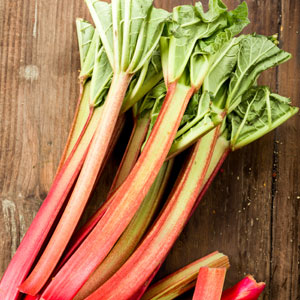Rhubarb Growing Guide

What is Rhubarb?
Rhubarb (Rheum x hybridum) is a rhizomatous herbaceous perennial that is a vegetable that we use as a fruit. Part of the Polygonaceae family, it is native to China, Tibet, Himalayas and Northern Central Europe. Rhubarb is a plant that prefers cool climates for results and needs a cold snap over Winter to help it come out of it’s dormancy. In Spring, the woody rhizome will send out large green leaves (which are toxic) on green stems that will turn red as they mature.
When planting your rhubarb it needs a full sun to part shade positing that has well drained fertile soil. The plant’s crown should be planted at the soils surface. Make sure that the plant gets adequate water. The soil needs to remained moist during the growing period. Once planted let your new plant settle in for the first 12 months without harvesting any stalks as the plant continues to develop. A little patience could have your rhubarb plant producing for you for the next 20 years. Start harvesting from the second year onwards. Harvest stems by pulling the thickest stalks gently off the crown. Ensure the whole stem comes away as any stub left could rot and cause disease. Only the stems of Rhubarb are edible, leaves are VERY toxic to both humans and animals, however safe to compost. Do not take more than half the stalks off any one plant.
Crowns can be left undisturbed for up to 5 years before needing to be divided. Rhubarb plants can be divided by cutting through the crown (the center of the plant), making sure that the ‘eyes’ are present on each division. Each piece will need to have an eye and a set of good healthy roots. When dividing split the clump vertically through the top with a sharp spade. This will help prevent damage to the growing points and ensure that roots are attached to each piece.
Benefits of Growing Rhubarb
Rhubarb is very easy to grow plant and is a tasty ornamental addition to the vegetable garden. It is rich in iron, fibre and vitamins A, C and K. It is used as a ‘fruit’, and can be baked in pies and crumbles or made into sauces, chutneys and relishes. The stalks can be stored for up to two weeks if at correct temperature and humidity conditions are maintained. Rhubarb is very frost hardy.
How to Grow Rhubarb
Climatic Zones
Cool, temperate, arid.
Plant Size
Height: 90cm, Width: 90cm
When To Plant Rhubarb
Plant in Winter.
Soil Preparation
Well drained and very rich soil with lots of organic matter. Before planting mix through well broken down compost to the soil.
How To Plant Rhubarb
Plant in full sun to part shade, 1-1.5m apart. Dig a hole large enough to accommodate the root mass. The crown of the plant (where the leaves and roots meet) should be planted at the soil surface. Cover the roots with soil and water the plant well. If planted too deep it can cause rotting and death to the plant. Ideally, plants can be placed into mounded beds, and this will assist with any drainage problems.
Rhubarb Plant Care
Rhubarb likes a lot of water and surround by moist soil. Do not allow plants to dry out as this will inhibit growth.
Mulch with extra compost each year after the leaves have died down in late Autumn to early Winter.
After planting add a cup of general purpose fertiliser per plant. They thrive with regular composting. Be sure not to use fresh manure as this is too acidic and will burn it.
During Winter trim and clean up the crown of any dead stalks and foliage. Mulch and fertilise. After many seasons and if needed, dig up and divide the crown to ensure another good growing season.
Watch out for snails and slugs around the large leaves. The crown is perceptible to crown rot.







